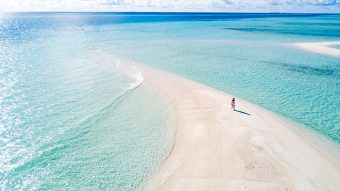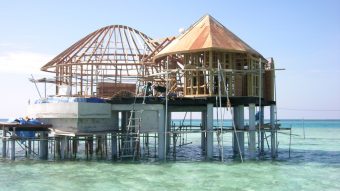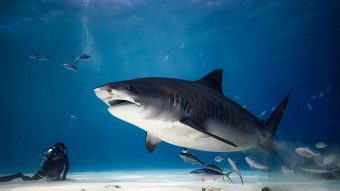
Baa Atoll Conservation Project
[vc_row][vc_column width=”1/1″][vc_column_text el_class=”columns_2″]
In 2011 Baa Atoll was recognized as a UNESCO biosphere reserve, a first for the Maldives. It was the result of many years of toil by the government, with the backing of the UNDP and the Global Environment Facility (GEF). It started out as a project, the Atoll Ecosystems Conservation (AEC) Project, formulated by the government between 2000 and 2002. “The idea was to create a pilot project to manage the environmental resources in an atoll in a sustainable way, with the support and involvement of the community,” said Abdulla Shibau, Managing Director of the Baa Atoll Conservation Fund. It would also serve as an example to other atolls in the country.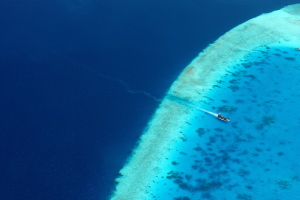
The idea behind the AEC project was pertinent to the distinctive geography and ecology of the country, its socio-economic development and resource use patterns. In such a setting, where all life and development programs are closely dependent on maintaining the atoll ecosystem in a healthy natural state, biodiversity conservation had to be part of every decision.
The ultimate objective of the AEC project was to protect the country’s biodiversity. However, the more immediate aim of the project was to devise and introduce a system of natural resource use, development planning and management that integrated conservation in this way by ensuring that resource uses were ecologically sustainable and socially beneficial, and that biodiversity was sufficiently protected while pursuing development activities.
Baa Atoll was chosen because of its proximity to Male’, and because of the wealth of its natural resources, which include the marine protected area, Hanifaru, renowned for its mega fauna; the whale shark and manta ray, which gather in impressive numbers during the south west monsoon to feed on high concentrations of zooplankton.
The atoll also has a number of resorts and its inhabitants are engaged in agriculture and fisheries, creating a conflict in resource use. “They are all fighting over the same resource, which is the environment.” Shibau said. So it was, in many ways, an exemplary place to pilot such a project. The project’s inception workshop was held in 2004. “We used a bottom up approach from day one, in consulting with stakeholders and discussing with the relevant government authorities, to find out what needed to be done to achieve the project’s objectives.” Shibau said.
The project had three objectives according to Shibau. One was to integrate the importance of safeguarding biodiversity into existing, and future government policies. “It could be the environmental action plan, or the tourism master plan, but while formulating these, the environment had to be at the forefront,” Shibau said. “The policies of other government agencies had to be aligned with this, since we are party to the convention on biological diversity, and have ratified it.”
The second objective was conservation of biodiversity. It would be hard to overstate the importance of coastal and marine ecosystems in a country like the Maldives. Biodiversity and ecosystems perform an immense role in supporting the economy of the country as its main economic activities – tourism and fisheries – depend on the continued maintenance of a rich and diverse species base. “We conducted an economic valuation study to find out how much biodiversity contributed to the country’s economy and we found out that over 80% of our GDP comes from biodiversity related sectors.” Shibau said.
The third objective was to improve the livelihood of the community. Due to the design of the project, there was not much focus on livelihood. “So we did not get any funds from GEF, and instead had to approach UNDP.” Shibau said.
There was also a need for a sustainable financing mechanism for the project to become successful. “We decided to establish a Baa Atoll Conservation Fund from the very beginning. We told the Baa Atoll community that at the end of the day, if everything went well, we’d be coming up with this Fund, which will give out grants to the atoll community.” The project sought the assistance of a conservation finance specialist and found out that there was potential in Baa Atoll to generate finance. “We saw how much safari vessels entered the Hanifaru area, and how much resorts and other interested parties utilized the area. And on top of that, when the BBC and National Geographic Channel covered the area, we gained a lot of exposure and there was a surge in tourist interest in that area. So after consulting the communities, resorts and atoll councils we drafted a Hanifaru management plan, which is empowered by the Environment Protection and Preservation Act, to manage the area. Under the plan we charge a user fee for people using the area, which goes into the Conservation Fund.” The Fund also gets finances through partnership agreements with resorts and dive schools, who contribute annually. “We already have partnership agreements with three resorts and we’re focusing on getting three more resorts, so that the remaining two will join in.” Shibau said.
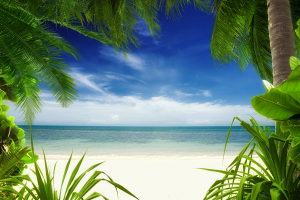 After mid-term evaluations in 2009, which affirmed that the project was on track and in line with the ecosystem approach, the idea for making the atoll a biosphere reserve was suggested by UNESCO. “We got in touch with the then tourism, fisheries and environment ministers, and gave presentations explaining biosphere reserves and the benefits that come with them,” Shibau said. “Being declared a biosphere reserve would benefit the community, because it would help sell the Conservation Fund. We also lobbied the then Vice President Dr. Waheed Hassan Manik, who suggested that it should be implemented under the ecosystem approach, which is a bottom-up one and that it should not be imposed on the community. So we drafted letters explaining biosphere reserves, their benefits and challenges, and sent them with leaflets to every household in the atoll. We also informed interested parties on it, in schools and elsewhere. Then we conducted an opinion survey in the community, which found that over 85% was in favor of declaring the atoll a biosphere reserve.”
After mid-term evaluations in 2009, which affirmed that the project was on track and in line with the ecosystem approach, the idea for making the atoll a biosphere reserve was suggested by UNESCO. “We got in touch with the then tourism, fisheries and environment ministers, and gave presentations explaining biosphere reserves and the benefits that come with them,” Shibau said. “Being declared a biosphere reserve would benefit the community, because it would help sell the Conservation Fund. We also lobbied the then Vice President Dr. Waheed Hassan Manik, who suggested that it should be implemented under the ecosystem approach, which is a bottom-up one and that it should not be imposed on the community. So we drafted letters explaining biosphere reserves, their benefits and challenges, and sent them with leaflets to every household in the atoll. We also informed interested parties on it, in schools and elsewhere. Then we conducted an opinion survey in the community, which found that over 85% was in favor of declaring the atoll a biosphere reserve.”
After a few years, in 2011 in Dresden Germany, Baa Atoll was declared a UNESCO Biosphere Reserve. The Reserve and the Fund was officially launched by the former President Dr. Waheed Hassan in June, 2012.
When the AEC project began, there was only one protected region in Baa Atoll “Dhigalihaa”. At its termination there are ten protected areas, and it has seen the establishment of a Conservation Fund, a Biosphere Reserve and a Biosphere Reserve Office located in Baa Atoll Eydhafushi. The office is funded by the government, and its work plan is funded by the Conservation Fund. Moreover, the Conservation Fund has already received proposals for its first cycle of grants. “Ownership is everything,” says Shibau. “When the people see that they are benefiting directly, they will take responsibility.”
[/vc_column_text][/vc_column][/vc_row]



